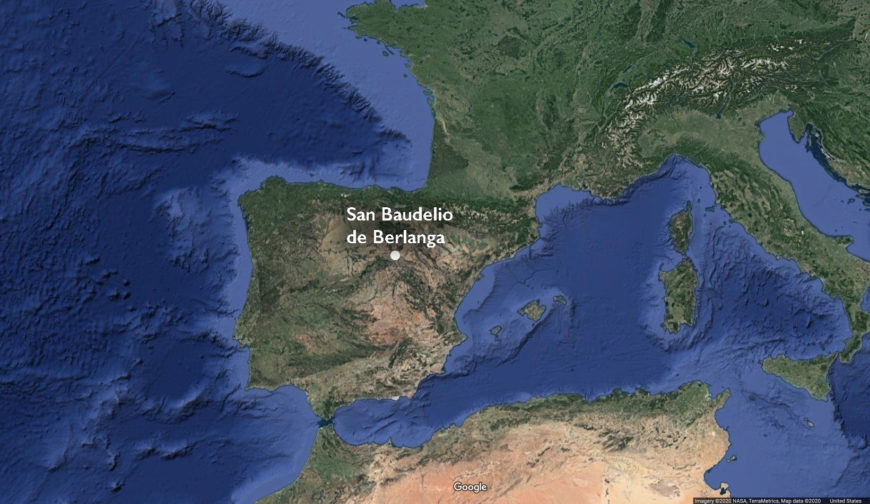Camel, first half of the 12th century, fresco transferred to canvas, from San Baudelio de Berlanga, Spain (Met Cloisters, New York)
Introduction
The Romanesque hermitage of San Baudelio de Berlanga was built in the eleventh century in the border zone of Islamic and Christian territories in what is today Spain. While it may seem isolated today, in the eleventh century it was situated on an old Roman road that came from southern France that bustled with activity. It brought merchants as well as pilgrims going to visit the relics of the early Christian martyr St. Baudilus in Nîmes. The hermitage’s architectural style is often called mozarabic, a term used to describe Christians living under Muslim rule and who drew from Arabic visual culture.
More than a century later, the building’s interior was transformed with the addition of brightly painted frescoes. In the upper levels are scenes from the life of Christ. Below, and painted on a larger scale, are more secular scenes of animals, hunting, and illusionistic silk tapestries. Among the animals depicted is a camel seen in profile. The animals suggest the complex history of medieval Spain, because they are based on animals seen on Islamic luxury goods (such as ivories, metal objects, ceramics, and textiles).
Construction of the hermitage and the painting of the murals occurred during an important moment in medieval Spain, one which saw boundaries shifting between faiths and rulers. Since 711, much of the Iberian Peninsula (today, Portugal and Spain), had been ruled by the Umayyad caliphate. The Umayyads were heirs to Muhammad, who had initiated the spread of the faith of Islam in the 6th century. The Umayyads created a vast empire that spanned much of the eastern and southern Mediterranean world, and eventually they reached the Iberian Peninsula (Spain and Portugal) in 711. After seven years, they had conquered much of it from the Christian Visigoths. These new Muslim territories were called al-Andalus. Then, in 750, the Umayyads were supplanted by the Abbasids. The last ruler of the Umayyads fled to al-Andalus, creating a new dynasty there with Córdoba as its capital. It was called the caliphate of Cordoba. Al-Andalus would develop rich, complex artistic traditions—the result of a diverse population that included Christians, Jews, and Muslims.
Still, Christians would try to reconquer the Iberian Peninsula after 711, in what has been called the Spanish Reconquest (although this term is considered problematic). The ensuing centuries would mean that the borders between al-Andalus and Christian-ruled Iberia would frequently change. San Baudelio de Berlanga was initially built in a frontier zone, and then when it was painted in Christian-controlled kingdom. A sign that Christians were gaining ground in acquiring territories came in 1085, when King Alfonso VI conquered the important city of Toledo.
Umayyad rule ended in 1031 after Christian forces were finally able to defeat the powerful caliphate. What remained of southern Al-Andalus would be divided into taifas (independent principalities). (Despite the downfall of the Umayyads, other Muslim rulers would establish themselves on the Iberian Peninsula until 1492). Still, the murals–which would have been painted when the hermitage was more associated with a Christian kingdom–demonstrate that artists continued to draw on Islamic courtly arts.
Today, most of the hermitage’s murals are not in their original location, but were removed from the walls in the 1920s, mounted onto canvas, and acquired by different museums, including the Prado (Madrid), Cloisters (NYC), the Indianapolis Museum of Art, and the Museum of Fine Arts, Boston.
Terms and key ideas
- Al-Andalus, the Umayyads, and Islamic art in Spain
- Spanish “Reconquest”
- Romanesque murals
- Frontier zone
- Sacred and secular art
Test yourself with a quiz!
Camel from San Baudelio de Berlanga
Additional resources:
Read about the camel fresco on The Metropolitan Museum website
Read more about Romanesque art on Smarthistory
Jerrilynn Dodds, ed., Al-Andalus: The Art of Islamic Spain (New York: The Metropolitan Museum of Art, 1992)
Mojmir S. Frinta, “The Frescoes from San Baudelio De Berlanga.” Gesta 1/2 (1964): 9–13.
Charles T. Little, ed. The Art of Medieval Spain, A.D. 500–1200 (New York: The Metropolitan Museum of Art, 1993).
Elías Teres Navarro, El expolio de las pinturas murales de la ermita mozárabe de San Baudelio de Berlanga (Goya, 2007).
L. Schrader, “A Medieval Bestiary.” The Metropolitan Museum of Art Bulletin 44, no. 1 (Summer 1986).
For the classroom
Take notes while watching the video, using the Camel active note-taking activity.
Discussion questions
- What does the camel fresco reveal about Romanesque art in Spain?
- How does the camel fresco compare to other examples of Spanish Romanesque art, such as the frescoes of the Circle of the Master of Pedret or the historiated capitals of Sant Miquel, Camarasa?
- What similarities are there between the camel fresco and the Pyxis of al-Mughira?
- How do the camel fresco, synagogues of Toledo, and Book of Morals of Philosophers reveal the complex culture of medieval Spain?
Research topics
- Art created in frontier zones often displays amazing innovations and adaptations as a result of entangled cultural and visual practices. What does studying art made in these so-called frontier zones (including such spaces as San Baudelio de Berlanga and the Church of St. Nicholas, Balinesti in Romania), reveal about the Middle Ages?


